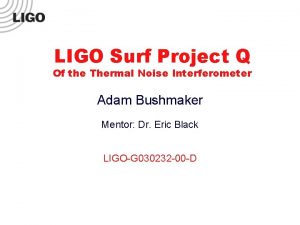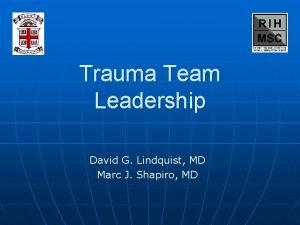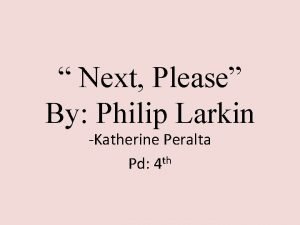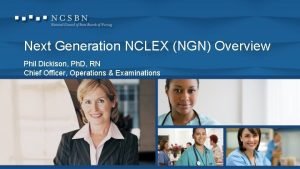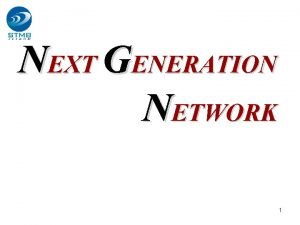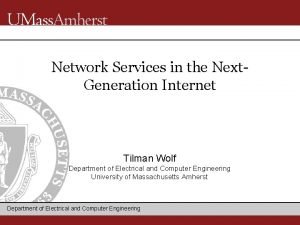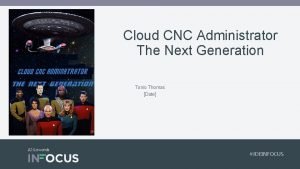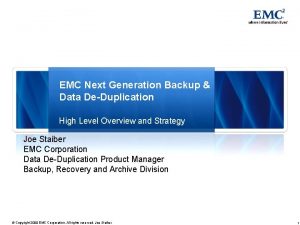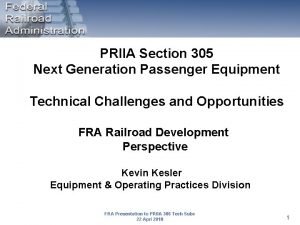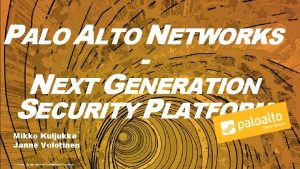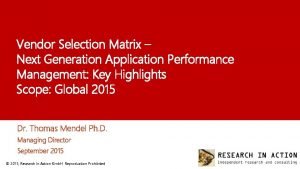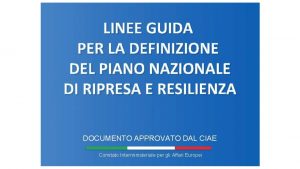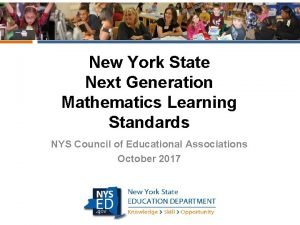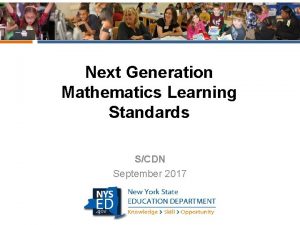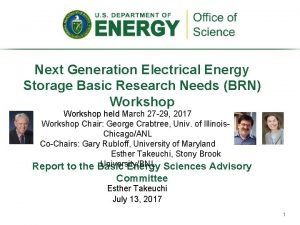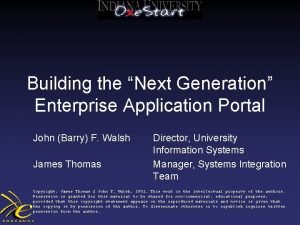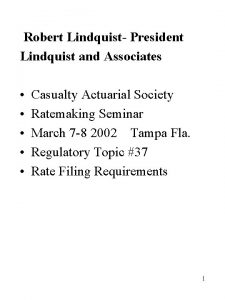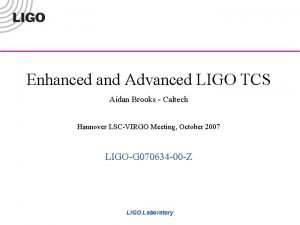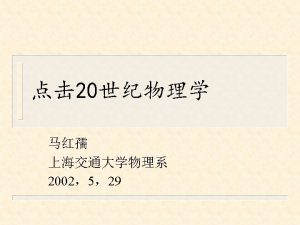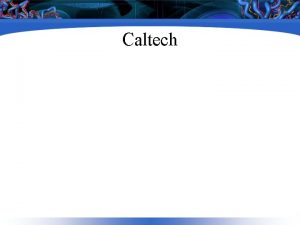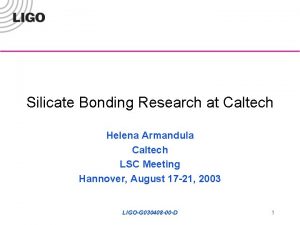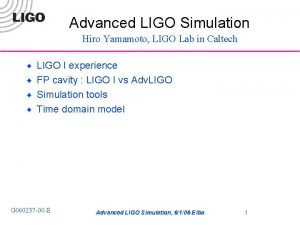Advanced LIGO The Next Generation Philip Lindquist Caltech

























- Slides: 25

Advanced LIGO The Next Generation Philip Lindquist, Caltech XXXVIII Moriond Conference Gravitational Waves and Experimental Gravity March 23, 2003 LIGO-G 030041 -01 -P LIGO Laboratory 1

The LIGO Mission To develop the field l LIGO infrastructure is in place » Designed to support the evolving field of gravitational wave science LIGO-G 030041 -01 -P LIGO Laboratory 2

The LIGO Mission To develop the field l LIGO infrastructure is in place » Designed to support the evolving field of gravitational wave science l Initial LIGO is in operation » Sensitivity is improving steadily, approaching goal » Observations are yielding first astrophysical results LIGO-G 030041 -01 -P LIGO Laboratory 3

Livingston 4 km Sensitivity History May 01 Jan 03 LIGO-G 030041 -01 -P LIGO Laboratory 4

The LIGO Mission To develop the field l LIGO infrastructure is in place » Designed to support the evolving field of gravitational wave science l Initial LIGO is in operation » Sensitivity is improving steadily, approaching goal » Observations are yielding first astrophysical results l l One year of integrated observation time is planned Detection is plausible with the initial LIGO-G 030041 -01 -P LIGO Laboratory 5

The LIGO Mission To develop the field l LIGO infrastructure is in place » Designed to support the evolving field of gravitational wave science l Initial LIGO is in operation » Sensitivity is improving steadily, approaching goal » Observations are yielding first astrophysical results l l l One year of integrated observation time is planned Detection is plausible with the initial LIGO With or without detection, astrophysical community will want/demand more sensitive detectors Advanced LIGO-G 030041 -01 -P LIGO Laboratory 6

Advanced LIGO Reach l Next Detector » Must be relevant for astrophysics » Should approach limits of reasonable extrapolations for detector physics and technologies » Should lead to realizable, practical, reliable instrument » Should exist neither too early nor too late LIGO-G 030041 -01 -P LIGO Laboratory 7

Advanced LIGO Reach l Next Detector » Must be relevant for astrophysics » Should approach limits of reasonable extrapolations for detector physics and technologies » Should lead to realizable, practical, reliable instrument » Should exist neither too early nor too late l Advanced LIGO » >10 X sensitivity, ~ 3000 in rate (population density dependent) » ~2. 5 hours = 1 year of initial LIGO-G 030041 -01 -P LIGO Laboratory 8

Astrophysical Reach l l Neutron Star and Black Hole Binaries Spinning Neutron Stars NS Birth (Super Novae, AIC) Stochastic Background (Chart by Kip Thorne) LIGO-G 030041 -01 -P LIGO Laboratory 9

Projected Advanced LIGO Performance l Suspension thermal noise l Internal thermal noise l Newtonian background, estimate for LIGO sites Initial LIGO 10 -22 10 -23 l l Seismic “cutoff” at 10 Hz h(f), Hz-1/2 10 -24 Unified quantum noise dominates at most frequencies for full- 10 -25 power, broadband tuning 1 Hz LIGO-G 030041 -01 -P 10 Hz LIGO Laboratory 100 Hz 1 KHz 10

Advanced LIGO Basic Configuration Current LIGO Power recycled Fabry-Perot to increase storage time LIGO-G 030041 -01 -P LIGO Laboratory 11

Advanced LIGO Basic Configuration Current LIGO Power recycled Fabry-Perot to increase storage time Advanced LIGO Increased Power Heavier Test Masses Quad Suspensions Improved Isolation Signal Recycling LIGO-G 030041 -01 -P LIGO Laboratory 12

Signal Recycling l Can focus sensitivity where needed » Sub-wavelength adjustments of resonance in signal recycling cavity l Allows optimization » Technical constraints » Astrophysical signatures LIGO-G 030041 -01 -P LIGO Laboratory 13

Limits to Sensitivity--Thermal Noise Thermal motion is proportional to ÖLmechanical Low-loss materials and techniques needed l » Test masses: crystalline sapphire, 40 kg, 32 cm diameter » Suspensions: fused silica » Monolithic final stages » Multiple pendulums for control and seismic attenuation (GEO 600) LIGO-G 030041 -01 -P Optical coating also source of mechanical loss, development underway LIGO Laboratory 14

Limits to Sensitivity--External Forces l Coupling of seismic noise through isolation system suppressed using active servo controls, passive “pendulum” isolation » Two 6 -degree-of-freedom platforms stabilized from 0. 03 to 30 Hz » Net suppression of motion in gravitational-wave band is 13 orders of magnitude or more » Suppression of motion below the band also critical to hold sensing system (control) in linear domain, avoid up-conversion LIGO-G 030041 -01 -P LIGO Laboratory 15

Low-Frequency Limit l Newtonian background is limit for ground-based detectors (~10 Hz) » Time-varying distribution of mass in vicinity of test mass » Seismic compression, rarefaction of earth dominates » Advanced LIGO targeted to reach this limit for our sites l For GW astrophysics below 10 Hz, space-based instruments needed ® LISA LIGO-G 030041 -01 -P LIGO Laboratory 16

Advanced LIGO Proposal l Submitted February 2003 (NSF PHY-0328418) Prepared a “bottoms up” cost estimate (approximately 5000 detailed line items) LIGO-G 030041 -01 -P LIGO Laboratory 17

Advanced LIGO Proposal l l Submitted February 2003 (NSF PHY-0328418) Prepared a “bottoms up” cost estimate (approximately 5000 detailed line items) Total Cost Estimate: $240, 000 LIGO-G 030041 -01 -P LIGO Laboratory 18

Advanced LIGO Proposal l Submitted February 2003 (NSF PHY-0328418) Prepared a “bottoms up” cost estimate (approximately 5000 detailed line items) Total Cost Estimate: $240, 000 Proposed LIGO Cost $122, 000 (fabrication plus some salaries for installation, specialty engineering, added outreach) LIGO-G 030041 -01 -P LIGO Laboratory 19

Advanced LIGO Proposal l l Submitted February 2003 (NSF PHY-0328418) Prepared a “bottoms up” cost estimate (approximately 5000 detailed line items) Total Cost Estimate: $240, 000 Proposed LIGO Cost $122, 000 (fabrication plus some salaries for installation, specialty engineering, added outreach) $25. 5 million provided by collaborators » GEO (Hanover, Birmingham, Rutherford, Glasgow) » ACIGA LIGO-G 030041 -01 -P LIGO Laboratory 20

Advanced LIGO Timeline l Initial LIGO Observation 2002 – 2006 » 1+ year observation within LIGO Observatory » Significant networked observation with GEO, LIGO, TAMA l Structured R&D program to develop technologies 1998 2005 » Conceptual design developed by LSC in 1998 » Current Cooperative Agreement carries R&D to Final Design, 2005 l l Proposal submitted in Feb 2003 for fabrication, installation Long-lead purchases planned for 2004 » Sapphire Test Mass material, seismic isolation fabrication » Prepare a ‘stock’ of equipment for minimum downtime, rapid installation l Start installation in 2007 » Baseline is a staged installation, Livingston followed by Hanford Observatories l Start coincident observations in 2009 LIGO-G 030041 -01 -P LIGO Laboratory 21

Proposed Funding Profile l l l Long lead procurements begin in 2004 Procurements peak in 2006 Installation begins in 2007 LIGO-G 030041 -01 -P LIGO Laboratory 22

The Advanced LIGO Community l l Scientific impetus, expertise, and development provided by LIGO Scientific Collaboration (LSC) » Synergy, critical mass (400+ individuals, 100+ graduate students, 40+ institutions) » International support and significant material participation » Especially strong collaboration with German-UK GEO group, capital partnership Advanced LIGO design, R&D, and fabrication shared with participants » LIGO laboratory leads, coordinates, is responsible for observatories Continuing support from NSF at all levels International network growing: VIRGO, GEO-600, TAMA, ACIGA LIGO-G 030041 -01 -P LIGO Laboratory 23

Advanced LIGO Status Summary l Initial LIGO is in operation » » l We are preparing publications from first science run Second science run underway Third science run at target sensitivity scheduled to begin next year Discovery plausible Advanced LIGO on the horizon » Advanced R&D and baseline design proceeding » Strong international partnership—GEO, ACIGA » Plan supports start of installation in 2007 Gravitational Waves: new tool for understanding the Universe, complementary to other observational methods, becoming a reality LIGO-G 030041 -01 -P LIGO Laboratory 24

Acknowledgements l National Science Foundation » NSF PHY-9210038 (Construction and Initial Operations) » NSF PHY-0107417 (Current Operations) l l Gary Sanders, LIGO Deputy Director David Shoemaker, Advanced LIGO Project Lead LIGO-G 030041 -01 -P LIGO Laboratory 25
 Ligo surf
Ligo surf X.next = x.next.next
X.next = x.next.next Martin lindquist
Martin lindquist David lindquist md
David lindquist md Next please philip larkin analysis
Next please philip larkin analysis We worship you hallelujah
We worship you hallelujah First gen antipsychotics
First gen antipsychotics Nclex next generation
Nclex next generation Next g network
Next g network Network as a service for next generation internet
Network as a service for next generation internet The next generation
The next generation Kintranet
Kintranet Ncsbn clinical judgement measurement model
Ncsbn clinical judgement measurement model What is deca's mission
What is deca's mission Next generation backup
Next generation backup Next generation equipment committee
Next generation equipment committee Next-generation digital services
Next-generation digital services Next generation security platform
Next generation security platform Vendor management matrix
Vendor management matrix Struttura pnrr
Struttura pnrr Next generation learning standards nys
Next generation learning standards nys Next gen math standards
Next gen math standards Next generation electrical technologies
Next generation electrical technologies Next generation assessments examples
Next generation assessments examples Next generation enterprise applications
Next generation enterprise applications What is deca
What is deca
